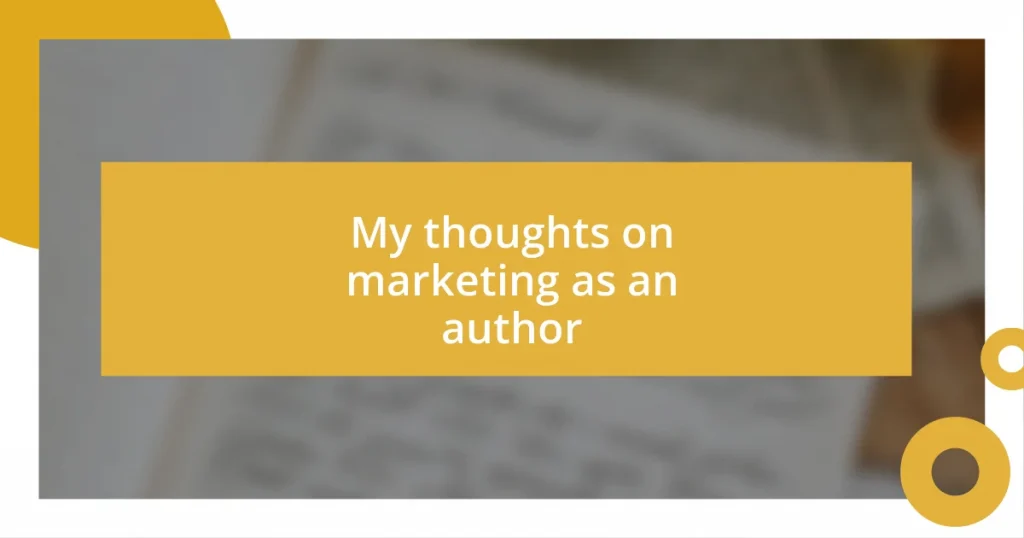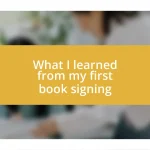Key takeaways:
- Social media is essential for authors to connect authentically with readers and build community through consistent engagement.
- Creating engaging content requires vulnerability and variety, encouraging relatable storytelling and interaction with the audience.
- Long-term marketing success relies on nurturing genuine relationships with readers, utilizing strategies like email marketing and thematic series to foster loyal connections.

Understanding author marketing strategies
Understanding author marketing strategies is vital for anyone looking to make their mark in the literary world. I recall the early days of my writing journey when I naively believed that simply publishing a book was enough for people to discover it. It was a reality check to learn that a solid marketing strategy is just as crucial as my writing. I found myself asking, “How do I genuinely connect with readers?”
Social media has become a playground for authors, and it’s a tool I now use without hesitation. I remember posting an excerpt from my book, fearing it might not resonate, but the engagement surprised me. Readers shared their thoughts, and I realized the power of authentic connection. It’s essential to showcase your personality; it makes readers feel more invested in you and your story.
Moreover, I’ve learned that setting clear goals for marketing can guide your efforts more effectively. Do you want to build a community, drive book sales, or establish your presence as an expert? I often reflect on these questions, ensuring my strategies align with my long-term aspirations. Each decision I make, from collaborations to blog posts, has to echo my core purpose as an author, and that clarity truly boosts my confidence and commitment.

Utilizing social media effectively
Social media is not just a platform; it’s where I can share snippets of my journey, engage with readers, and build a community. I vividly recall a time when I hosted a live Q&A session on Instagram. I was nervous, but the questions poured in, and the instant feedback was invigorating. It transformed a simple session into an interactive conversation, reinforcing the idea that social media can bridge the gap between authors and their audience.
When I analyze the different social media platforms, each has its unique strengths. For instance, Twitter allows for quick updates and real-time interactions, while Instagram thrives on visual storytelling. I often find myself tailoring my content to fit the platform’s nature, ensuring that I’m not just broadcasting my work but also engaging my audience thoughtfully. Not every post has to be about my book; sometimes, sharing a personal struggle or a behind-the-scenes moment resonates more deeply. By being authentic and varied in my posts, I feel I’m not just promoting my work but also building a genuine connection.
Consistency is key when utilizing social media effectively. I’ve learned the hard way that disappearing for weeks can make followers forget about my work. I aim for a regular posting schedule, which doesn’t have to be overwhelming—sometimes, it’s just sharing a thought or an inspiring quote. This way, I stay on my readers’ minds and create an ongoing dialogue that fosters loyalty and excitement around my writing.
| Platform | Key Features |
|---|---|
| Real-time engagement, quick updates | |
| Visual storytelling, engagement through images | |
| Community building, group interactions | |
| Professional networking, thought leadership |

Creating engaging content for readers
Creating engaging content requires a balance between authenticity and creativity. For me, the real magic happens when I share moments that resonate on a human level. I recall writing a blog post about my struggle with writer’s block, and to my surprise, the response was overwhelmingly positive. Readers shared their own battles, and this not only created a bond but also gave me new ideas for future stories. When you express vulnerabilities, it invites others to engage and relate, ultimately forming a deeper connection.
- Use storytelling to illustrate your points, making your content relatable.
- Include personal anecdotes that encourage readers to see themselves in your experiences.
- Embrace vulnerability; it creates trust and rapport with your audience.
- Ask questions in your posts to invite interaction and comments.
- Mix different content types—videos, articles, images—to keep your audience’s attention.
Engaging content thrives on variety and interactivity. I’ve found that when I switch up my posts—sometimes sharing a quirky doodle, at other times a thought-provoking quote—my audience seems to react more enthusiastically. There was a day I decided to share a quick behind-the-scenes video of my writing space. The comments flooded in, with readers revealing their own creative spaces. It’s those small, spontaneous moments that can spark an engaging dialogue and keep readers coming back for more.

Measuring marketing success and adjusting
Measuring marketing success often comes down to analyzing metrics that truly reflect engagement and interest. I remember diving into my social media analytics one evening, feeling a mix of anticipation and anxiety. I was pleasantly surprised to find that a simple poll I ran garnered more interaction than any promotional post. This taught me that sometimes it’s the straightforward activities that resonate more with my audience, showcasing their preferences and desires.
Adjustments are just as crucial as measurement. For example, after noticing a drop in engagement on my newsletter, I decided to experiment with a new format—each issue now features a spotlight on a reader’s story related to my work. I couldn’t believe how much more feedback I received after pivoting to this more community-driven approach. It made me realize how vital it is to stay flexible and open to change; what worked yesterday might not work today.
When I think about marketing success, I often reflect on what encourages lasting connections. Have you ever felt that thrill of a comment or message that clearly shows someone was touched by your words? For me, those moments are a reminder that the numbers alone don’t tell the whole story. Instead, the authentic interactions I cultivate are what truly measure my success and guide my adjustments in strategy.

Long-term marketing strategies for authors
Long-term marketing strategies for authors often hinge on building an authentic relationship with readers over time. I can’t stress enough the importance of consistent engagement. A few years back, I decided to host a monthly live Q&A on social media. The first time, I felt nervous, wondering if anyone would show up. To my delight, a small but dedicated group joined in, and those conversations deepened my connection with them. Now, I look forward to those sessions as not just promotional tools, but as opportunities to foster real community.
Another key strategy is to create a series around specific themes that resonate with your audience. When I began a series exploring the inspiration behind my books, it not only kept my content cohesive but also drew readers in week after week. They started sharing what inspired them as well, which turned our interaction from a one-way street into a lively conversation. It’s fascinating how shared experiences can broaden your reach and make your audience feel like they’ve invested in your journey.
Lastly, don’t underestimate the power of email marketing—an often overlooked but valuable tool. I’ve built a dedicated mailing list by offering exclusive content and sneak peeks at upcoming projects. When I crafted an email showcasing a behind-the-scenes look at my writing process, the response was incredible. Readers expressed feelings of excitement and anticipation. My question for you: what can you offer your subscribers that makes them feel special? It’s this sense of exclusivity that can foster loyalty and keep readers engaged long-term.















